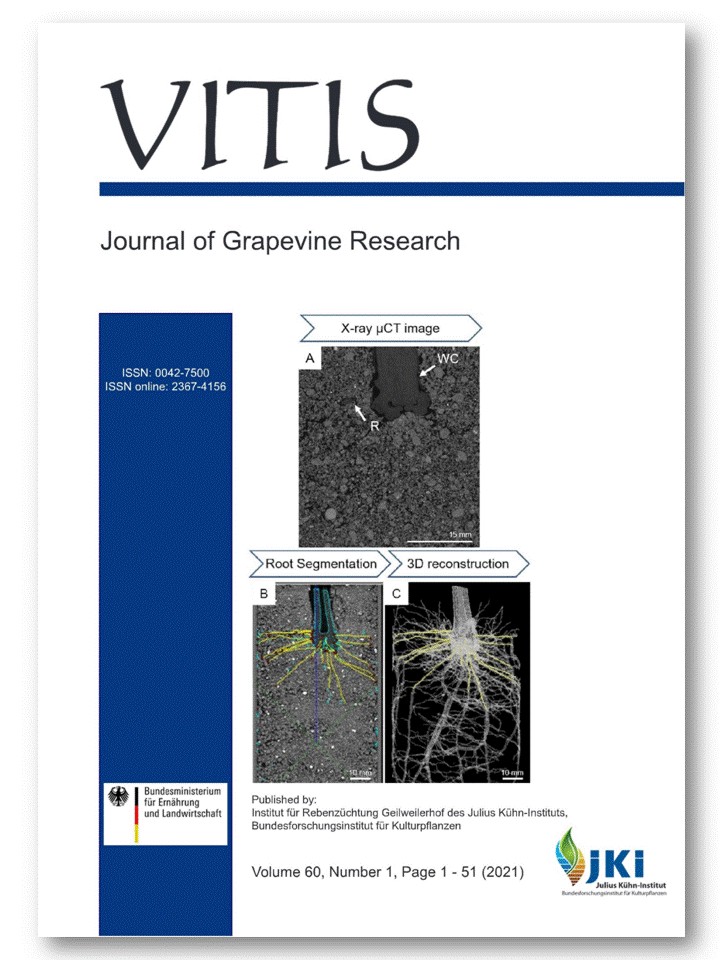Biological performance of the predatory mite Neoseiulus barkeri Hughes (Phytoseiidae): a candidate for controlling of three mite species infesting grape trees
DOI:
https://doi.org/10.5073/vitis.2021.60.11-20Keywords:
Neoseiulus barkeri; predation rate; biological control; phytophagous mites; grapes.Abstract
The life history and predation rate of Neoseiulus barkeri (Phytoseiidae) feeding on Colomerus vitis (Eriophyidae), Tetranychus urticae (Tetranychidae) and Brevipalpus lewisi (Tenuipalpidae) were determined in the laboratory at constant temperatures of 25, 30 and 35 °C, relative humidity of 50 ± 5 % and a photoperiod of 16:8 h (light:dark). Within the temperature range studied, the increase of temperature from 25-35 °C led to a shortened development period and an increased total predation rate and reproduction. Survival during immature stages development surpassed 94 % at all the temperatures from 25 to 35 °C. The highest fecundity (59.50, 48.25 and 35.30 eggs per female) was recorded at 35 °C, while the minimum (40.25, 31.00 and 20.50 eggs per female) was at 25 °C when N. barkeri fed on C. vitis, T. urticae and B. lewisi, respectively. It is demonstrated in the life table parameters that when the predatory mite N. barkeri is fed on C. vitis, the highest reproduction rates (rm = 0.195, 0.210 and 0.232 females/female/day) are obtained, while feeding on B. lewisi gave the minimum of reproduction rates (rm = 0.095, 0.105 and 0.115) at 25 °C, 30 °C and 35 °C, respectively. The population of N. barkeri multiplied 20.45, 22.63 and 24.89 times in a generation time of 16.80, 14.75 and 12.50 days when fed on C. vitis at the same temperatures mentioned above, respectively, while N. barkeri multiplied 10.70, 12.88 and 14.36 times in a generation time of 23.20, 21.11 and 18.08 days when fed on B. lewisi at the same temperatures, respectively. This shows that N. barkeri is a promising control agent for C. vitis, T. urticae and B. lewisi on grape trees.
Downloads
Published
Issue
Section
License
Copyright (c) 2021 The Author(s)

This work is licensed under a Creative Commons Attribution 4.0 International License.
The content of VITIS is published under a Creative Commons Attribution 4.0 license. Any user is free to share and adapt (remix, transform, build upon) the content as long as the original publication is attributed (authors, title, year, journal, issue, pages) and any changes to the original are clearly labeled. We do not prohibit or charge a fee for reuse of published content. The use of general descriptive names, trade names, trademarks, and so forth in any publication herein, even if not specifically indicated, does not imply that these names are not protected by the relevant laws and regulations. The submitting author agrees to these terms on behalf of all co-authors when submitting a manuscript. Please be aware that this license cannot be revoked. All authors retain the copyright on their work and are able to enter into separate, additional contractual arrangements.



